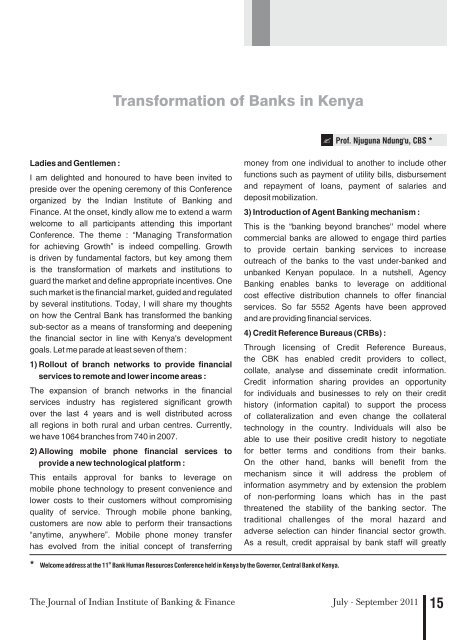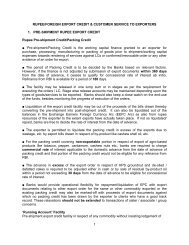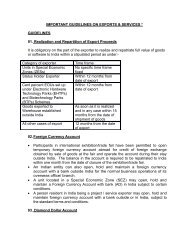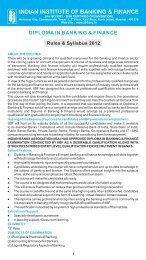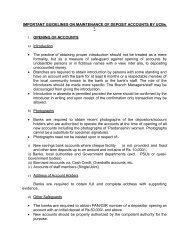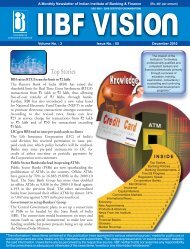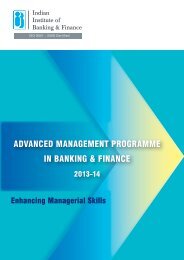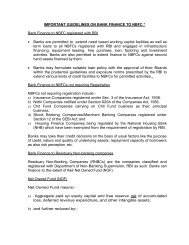special featureimproved customer service. Given the limitedgeographical coverage of each Bank, one would expectthat there would be large number of institutions in thecountry providing financial services to the remotest partsof the country.The most critical responsibility of an institution like thiswill be the financial well-being of the clients it serves. It isessential that it takes responsibility to provide its clientswith sound financial advice based on understanding ofthe client's needs and aspirations and not merely with theobjective of pushing its products and services. Such anapproach to financial services delivery requires that theinstitution trains its local branch staff with the approachesrequired to analyse each client's situation andrecommend appropriate solutions. This approach tightlycustomises a portfolio of financial products for ahousehold, depending on its unique needs and in theprocess, transfers complexity from the household to thefinancial services provider, while holding the providerresponsible for the quality of guidance and theappropriateness of the products offered to the householdon a longer term basis.These institutions, which will not be allowed to takedeposits, will link up with the banking system andmarkets for access to equity as well as funds and will besubject to regulation and oversight by the Reserve Bankof India.Overall, I believe that an approach to financial inclusionthat incorporates branch-based penetration into localareas, developing deep local insight, leveragingtechnology, designing multiple products to invokeeconomics of scope, and using a wealth managementapproach would have a greater chance of success thanrelying on models, which have not worked in the past.In conclusion, I would re-iterate that we have aconsiderable distance to go as a financial system, if onelooks at the dimensions of size, scope, depth andinnovations. Our approach to financial systemsdevelopment needs to be characterised by a willingnessto try multiple approaches. We must not remain weddedto historical directions. The country is too large anddiverse for any one approach to hold sway. Whiledeveloping large-sized financial institutions and marketsthat can meet the burgeoning needs of households, firmsand infrastructure in India, we also need to ensure thatsystemic stability is at all times an important concern.IT Vision Document : 2011 - 17The IT Vision of the Reserve Bank of India 2011-17 was prepared by a High Level Committee, chaired by Dr. K. C. Chakrabarty, DeputyGovernor with experts from varied backgrounds within and outside Reserve Bank as members.The objective of the IT Vision for 2011-17 is to enable IT as a strategic resource for (i) enhancing enterprise knowledge, (ii) improving customerservice, (iii) strengthening governance, (iv) increasing overall efficiency, and (v) ensuring environment friendly systems.The steps to attain the envisioned state have been identified as :- Adopting appropriate business process re-engineering and allocating resources before taking up the development of any new project;- Conforming to internationally accepted data standards;- Using business intelligence tools for analysing information;- Ensuring automated flow of data from the source systems of banks to their Management Information Systems (MIS) and then to theReserve Bank without any manual intervention;- Improving IT governance;- Effective project management;- Evolving well defined information policies as well as information security framework; and- Better vendor management and outsourcing practices.For commercial banks, enhanced use of IT in areas like MlS, regulatory reporting, adoption of technology based strategies for financialinclusion, need for risk mitigation, use of analytics for improved customer relationship management (CRM) have been set as priorities.The vision document discusses the need to move towards an integrated IT environment. Desirability of evolving a Centre of Excellence (CoE)for serving the technical and technological needs of the banking sector, which may also serve as a laboratory for research and developmentactivity has also been mentioned in the document.Department of Information Technology (DIT) in RBI would be the nodal department for coordinating and monitoring the progress ofimplementation of the recommendations of vision document.(Source : RBI, Annual Report 2010-11)14July - September 2011The Journal of Indian Institute of Banking & Finance
special featureTransformation of Banks in KenyaProf. Njuguna Ndung'u, CBS *Ladies and Gentlemen :I am delighted and honoured to have been invited topreside over the opening ceremony of this Conferenceorganized by the Indian Institute of Banking andFinance. At the onset, kindly allow me to extend a warmwelcome to all participants attending this importantConference. The theme : “Managing Transformationfor achieving Growth” is indeed compelling. Growthis driven by fundamental factors, but key among themis the transformation of markets and institutions toguard the market and define appropriate incentives. Onesuch market is the financial market, guided and regulatedby several institutions. Today, I will share my thoughtson how the Central Bank has transformed the bankingsub-sector as a means of transforming and deepeningthe financial sector in line with Kenya's developmentgoals. Let me parade at least seven of them :1) Rollout of branch networks to provide financialservices to remote and lower income areas :The expansion of branch networks in the financialservices industry has registered significant growthover the last 4 years and is well distributed acrossall regions in both rural and urban centres. Currently,we have 1064 branches from 740 in 2007.2) Allowing mobile phone financial services toprovide a new technological platform :This entails approval for banks to leverage onmobile phone technology to present convenience andlower costs to their customers without compromisingquality of service. Through mobile phone banking,customers are now able to perform their transactions“anytime, anywhere”. Mobile phone money transferhas evolved from the initial concept of transferringmoney from one individual to another to include otherfunctions such as payment of utility bills, disbursementand repayment of loans, payment of salaries anddeposit mobilization.3) Introduction of Agent Banking mechanism :This is the “banking beyond branches'' model wherecommercial banks are allowed to engage third partiesto provide certain banking services to increaseoutreach of the banks to the vast under-banked andunbanked Kenyan populace. In a nutshell, AgencyBanking enables banks to leverage on additionalcost effective distribution channels to offer financialservices. So far 5552 Agents have been approvedand are providing financial services.4) Credit Reference Bureaus (CRBs) :Through licensing of Credit Reference Bureaus,the CBK has enabled credit providers to collect,collate, analyse and disseminate credit information.Credit information sharing provides an opportunityfor individuals and businesses to rely on their credithistory (information capital) to support the processof collateralization and even change the collateraltechnology in the country. Individuals will also beable to use their positive credit history to negotiatefor better terms and conditions from their banks.On the other hand, banks will benefit from themechanism since it will address the problem ofinformation asymmetry and by extension the problemof non-performing loans which has in the pastthreatened the stability of the banking sector. Thetraditional challenges of the moral hazard andadverse selection can hinder financial sector growth.As a result, credit appraisal by bank staff will greatlyth* Welcome address at the 11 Bank Human Resources Conference held in Kenya by the Governor, Central Bank of Kenya.The Journal of Indian Institute of Banking & Finance July - September 2011 15


